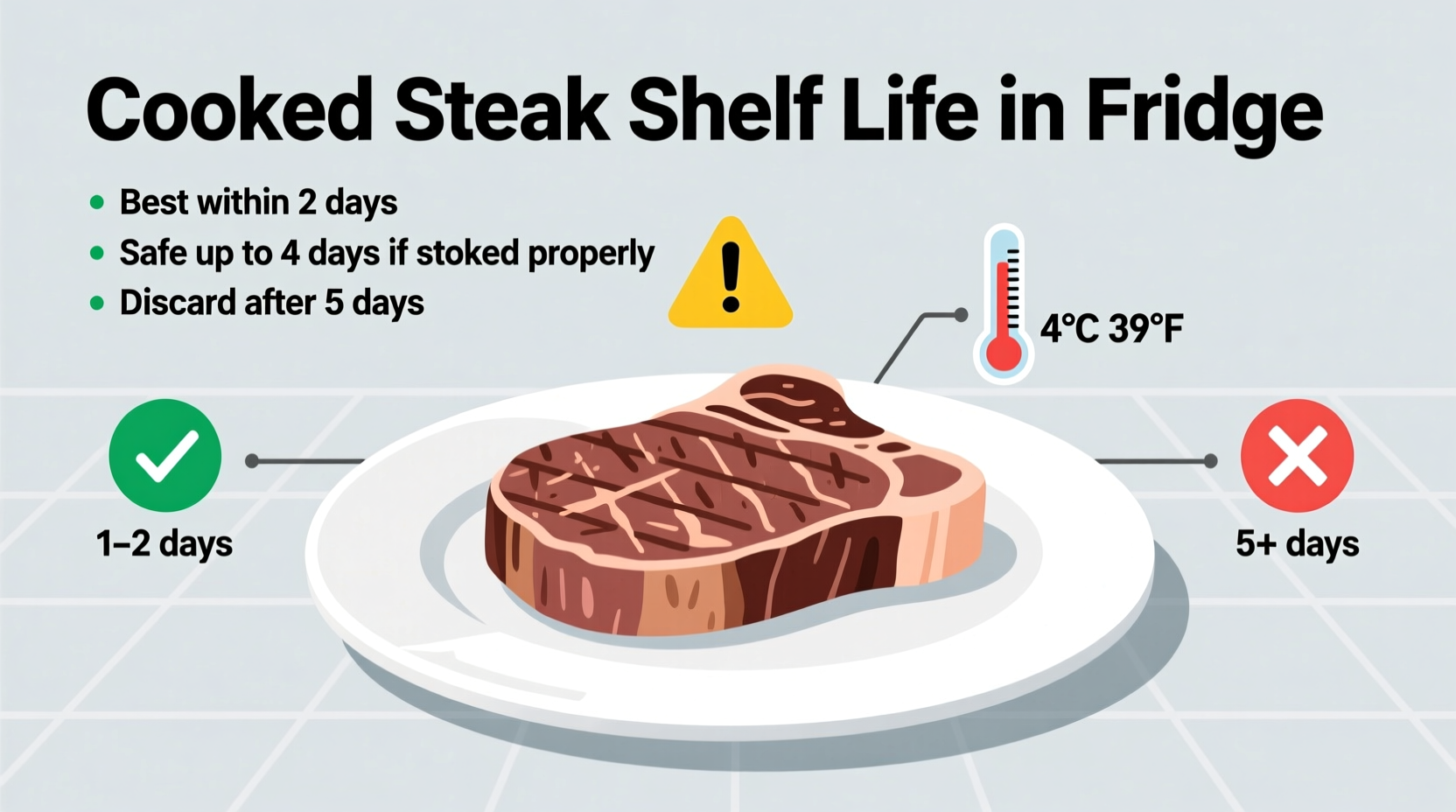Wondering how long does cooked steak last in fridge before it becomes unsafe to eat? Proper food storage isn't just about preserving flavor—it's critical for preventing foodborne illness. As someone who's worked in professional kitchens for over 15 years, I've seen how easily improper storage can compromise both safety and quality. Let's explore exactly how to handle leftover steak so you never have to question whether it's still good.
Understanding Cooked Steak Refrigeration Timeframes
The USDA Food Safety and Inspection Service clearly states that cooked steak maintains safety for 3-4 days in the refrigerator. This timeframe assumes your refrigerator maintains a consistent temperature of 40°F (4°C) or below—a critical factor many home cooks overlook.
| Storage Method | Temperature | Safe Duration | Quality Preservation |
|---|---|---|---|
| Refrigerator | ≤40°F (4°C) | 3-4 days | Good flavor retention |
| Freezer | 0°F (-18°C) | 2-3 months | Best texture preservation |
| Room Temperature | ≥40°F (4°C) | 2 hours max | Rapid quality deterioration |
This cooked steak storage comparison shows why refrigeration is essential for safety. The USDA's FoodKeeper app confirms these timeframes, emphasizing that proper storage prevents the growth of harmful bacteria like Staphylococcus aureus and Listeria monocytogenes.
Proper Storage Techniques for Maximum Safety
How you store your cooked steak significantly impacts its safe consumption window. Follow these professional kitchen practices:
- Cool rapidly – Divide large portions into smaller containers to cool faster (within 2 hours of cooking)
- Airtight containers – Use glass or BPA-free plastic containers with tight seals
- Shelf placement – Store on middle shelf, not in the door where temperature fluctuates
- Label everything – Note cooking date with marker directly on container
According to USDA's refrigerator safety guidelines, the "danger zone" for food is between 40°F and 140°F (4°C-60°C), where bacteria multiply rapidly. Never leave cooked steak at room temperature longer than 2 hours—or 1 hour if your kitchen exceeds 90°F (32°C).

Signs Your Cooked Steak Has Spoiled
While the 3-4 day rule provides a safety baseline, visual and sensory cues matter too. Discard cooked steak showing any of these warning signs that cooked steak has gone bad:
- Texture changes – Slimy or sticky surface (not to be confused with natural juices)
- Odor development – Sour, ammonia-like, or rotten smell (fresh cooked steak has mild meaty aroma)
- Color shifts – Grayish hue or green spots (not the normal brown from cooking)
- Mold appearance – Any visible fuzzy growth, even in small areas
Remember: "When in doubt, throw it out" is the cardinal rule of food safety. The USDA emphasizes that harmful bacteria don't always produce noticeable changes in food.
Reheating Leftover Steak Safely
Proper reheating brings your leftover steak back to safe eating condition. Follow these steps for how to safely reheat cooked steak:
- Remove from refrigerator and let sit at room temperature 10-15 minutes
- Heat to internal temperature of 165°F (74°C) as measured by food thermometer
- Use gentle methods like oven reheating (275°F/135°C) to prevent overcooking
- Consume immediately after reheating—don't re-refrigerate reheated steak
The CDC's cooking meat checklist confirms that proper reheating destroys potential pathogens that may have developed during storage.
Freezing Cooked Steak for Longer Storage
If you won't eat your steak within 3-4 days, freezing extends its safety indefinitely (though quality declines over time). For best practices for freezing cooked steak:
- Vacuum-seal portions for optimal protection against freezer burn
- Wrap tightly in heavy-duty aluminum foil before placing in freezer bags
- Remove as much air as possible from storage containers
- Label with contents and date (use within 2-3 months for best quality)
Common Storage Mistakes to Avoid
These frequent errors shorten your cooked steak's safe storage time:
- Storing while still hot – Creates condensation that promotes bacterial growth
- Using non-airtight containers – Allows moisture loss and odor absorption
- Ignoring refrigerator temperature – Use a thermometer to verify 40°F or below
- Stacking containers improperly – Blocks cold air circulation in refrigerator
Food safety experts at the FDA Food Safety Education Center note that these mistakes account for most cases of foodborne illness from leftovers.
Special Considerations for Different Steak Types
While the 3-4 day rule applies broadly, certain factors affect how long different cooked steaks last in fridge:
- Fat content – Higher fat cuts (like ribeye) may spoil slightly faster than lean cuts
- Cooking method – Sous vide cooked steak has different safety considerations
- Added ingredients – Steak with sauces or marinades may have shorter shelf life
- Initial freshness – Steak frozen then thawed before cooking has reduced storage time
When in doubt about specific circumstances, consult the USDA's FoodKeeper app for tailored recommendations based on your exact preparation method.











 浙公网安备
33010002000092号
浙公网安备
33010002000092号 浙B2-20120091-4
浙B2-20120091-4